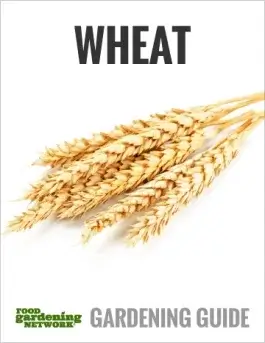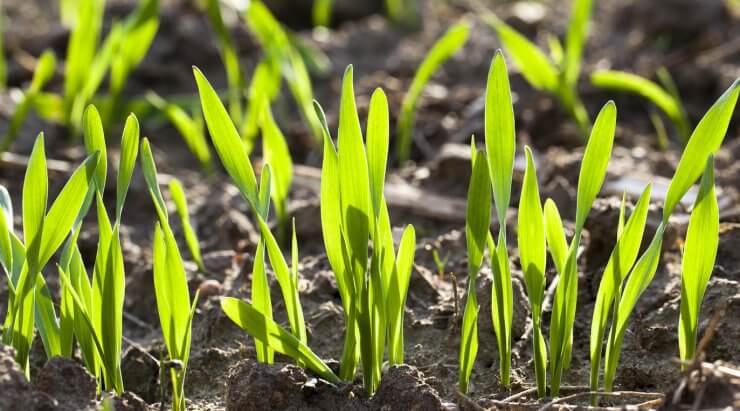
Wheat is one of the oldest crops in history and is grown around the world. In fact, the worldwide wheat crop is bigger than all the other crops grown in the world, all together. Have you ever wondered if you can grow wheat at home? Many people have, especially considering the over-use of glyphosate in commercially grown wheat. Some experts believe that the increasing amount of gluten sensitivity isn’t from gluten at all, it’s intolerance to the chemicals sprayed on our wheat crops. With so much uncertainty about where wheat comes from, it’s natural to want to grow wheat at home!

The good news is that although most of the world’s wheat is commercially produced, it is also easily grown in your back yard, and wheat isn’t fussy either, it just needs some space. Here are tips to grow wheat at home!

10 Tips to Grow Wheat at Home
1. Start by growing less than a bushel. A 20’ x 50’ plot will yield a bushel of wheat. A bushel equals 60 pounds of grain, which is enough to bake 90 loaves of bread. So, you can see that an area even half—or a quarter—of that size will make it worthwhile for you to grow this ubiquitous crop.
2. Follow the wheat-growing laws. By growing less than a bushel, this size of a wheat crop will also keep home gardeners like you well safe from the farm marketing quotas law established in 1938. According to the National Agricultural Law Center, “Farm marketing quotas are not applicable to a farm on which the acreage planted to wheat is not in excess of fifteen acres” or less than 200 bushels of wheat. So long as you keep your crop is within those parameters, you need not worry about legal actions.
3. Commit, or don’t. Wheat is an annual plant, so if you want to grow wheat at home, you’ll need to sow a new crop each year.
4. Let it grow, let it grow. Wheat is typically self-pollinating, and depending on the cultivar and growing conditions, wind and insects will help with the pollination process.
5. Plant by the season. There are two main types of wheat: spring wheat and winter wheat. As their names suggest, spring wheat is planted in spring for late-summer or fall harvest. Winter wheat is hardy to USDA Plant Hardiness Zones 3. Spring wheat can be grown in most zones, depending on the variety.
6. Grow from seeds. sown directly into the garden in the spring or fall. Spring wheat varieties are planted as soon as the ground is workable; the wheat will be ready to harvest in the summer. Winter wheat is sown in the fall, two or three weeks before the first frost is expected, lives through the winter, and then is harvested in the summer.
7. Protect the seeds. To grow wheat at home, after the seed is down, rake the area again and smooth out the soil to cover the seeds about an inch deep into the soil. This will help prevent the birds from eating them, but some gardeners cover the area loosely with straw for extra protection. If birds and rodents are persistent, cover the area with netting.
8. Grow in raised beds or open ground. Raised beds provide all-important drainage, while growing wheat in open-ground allows more room to grow. This crop grows well in an oblong space, making it perfect for borders or the end of a garden—though be sure you have enough space around at least one side for harvesting.
9. Plant in sunlight. Wheat requires full sun to thrive—a minimum of six hours of direct sunlight and eight or more is better.
10. Balance your soil. To grow wheat at home, your soil should be fairly neutral, about 6 to 7 pH and have a healthy amount of nitrogen and phosphorus. A soil test is your best bet for making sure you have the right pH and nutrients.
If you love growing your own wheat and want to keep growing wheat at home, rotate wheat to different parts of the garden every three to four years. After that time period, soil can build up a population of root-rotting diseases.
Like all food crops, wheat is susceptible to various fungal diseases. Your best weapons against these are making sure your seeds are disease-free to begin with (as many wheat diseases are seed-borne) and using best planting practices, which help prevent diseases from taking hold in the first place.
Learn How to Grow Wheat at Home
Grow wheat in your home garden? Yes! Wheat is grown on more land than any other commercial food in the world, and you can grow it in your back yard. You don’t need hundreds of acres or even a combine machine. With the all-wheat growing guide, you get all the details that go into raising wholesome, fiber-rich wheat of your own. We cover the history of wheat, planting wheat, harvesting and of course eating. You’ll also get nutritional benefits and some beauty tips using your amber waves of grain. Get it all in the Field Guide to Wheat Gardening Guide right now!
Do you grow wheat at home, or do you want to? Ask your burning questions in the comments below.


 Previous
Previous

